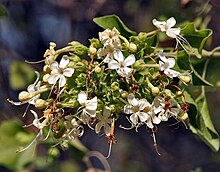Clerodendrum phlomidis
| Clerodendrum phlomidis | |
|---|---|

| |
| Scientific classification | |
| Kingdom: | Plantae |
| Clade: | Tracheophytes |
| Clade: | Angiosperms |
| Clade: | Eudicots |
| Clade: | Asterids |
| Order: | Lamiales |
| Family: | Lamiaceae |
| Genus: | Clerodendrum |
| Species: | C. phlomidis
|
| Binomial name | |
| Clerodendrum phlomidis | |
| Synonyms[1] | |
| |
Clerodendrum phlomidis is a species of flowering plant in the family Lamiaceae. The plant has been used in Ayurvedic medicine, and some Ayurvedic sources refer to it by the synonym Clerodendrum multiflorum.
In India, the plant is known as Arni. It is a large shrub common in India and Sri Lanka. Clerodendrum myricoides from the same family is found in Africa and India.[2]
Names
- Sanskrit name: Agnimantha, Jaya, Sriparni, Ganikarika, Jayanthi, Tarkari, Nadeyi, Vai jayanthi
- Hindi name: Urni, Arna, Aarni
- Malayalam name: Munja
Description
This herb belongs to family Verbenaceae/Lamiaceae. Leaves are ovate, opposite, deltoid, hairy from below and wavy. The flowers are in small rounded terminal panicle. The flowers bloom in August to February.
Flowers are white or pinkish and are very fragrant.
Usage
According to Indian ancient system of medicine Ayurveda, Dash Mool a very powerful combination of ten different roots to improve body vigor and maintain good health contains Clerodendrum phlomidis (Arni) Root.[3] The pulp obtained from the crushing of the leaves is applied externally on swelling.
References
- ^ "Clerodendrum phlomidis L.f.". World Checklist of Selected Plant Families. Royal Botanic Gardens, Kew. Retrieved 9 March 2014 – via The Plant List. Note that this website has been superseded by World Flora Online
- ^ Vaidya, B. G. and Adarsh, N.:(Uttarardh), Shri Swami Atamanand Sarsavati Ayurvedic. Government Pharmacy Ltd, Surat, pp. 815-820 (1965).
- ^ Anonymous.: The Ayurvedic Pharmacopoeia of India Government of India. Ministry of Health and Family Welfare, Dept. of ISM and Homeopathy, New Delhi Part 1, Vol. III, 1st Edn. (2001).
